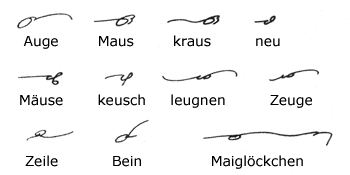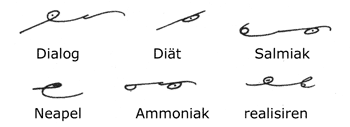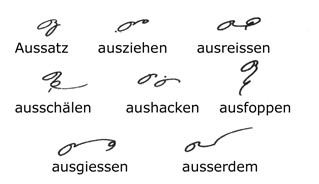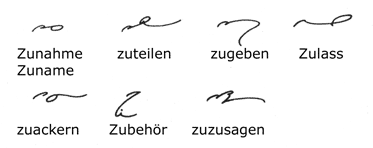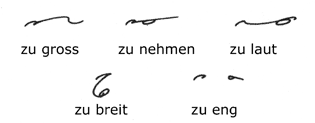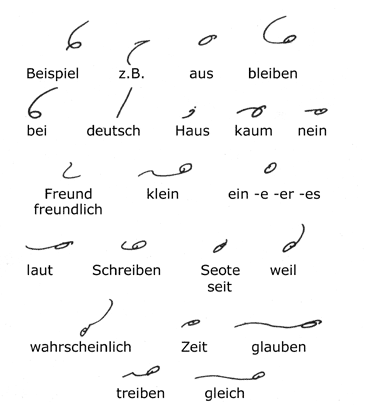| Home Reporting A Judge’s Charge Dupraw’s Notes Sklarew’s Notes Zoubek’s Notes Pre-Anniversary Description Reference Material Brief Form List Anniversary Description Reading Material Reference Material Brief Form List Most-Used Phrases Simplified Description Brief Form List Dupraw on Note Size Diamond Jubilee Description Brief Form List Expert Brief Form List Series 90 Description Brief Form List Centennial Description Brief Form List Taquigrafía Gregg Gramálogos German Gregg Manual Esperanto Gregg Manual Brief Forms Irish Gregg Manual Gregg Group Gregg Learning Forum Ms. Letha’s SH Site Shorthand³ Omniglot's Entry Wikipedia's Entry Stenospeed Dictation Practice Andrew Owen |
29. A diphthong is the sound produced by the union in one syllable of two simple vowel sounds uttered n rapid succession.
The diphthong AU is, of course, made up from the sounds A and U in the words nahe and Nuss, and it is therefore represented by the signs for these two sounds. The diphthong EU or AEU most nearly approximates to the O in Not and the I in Zinn. It is to be carefully noted that in a few words the circle falls outside the hook, as in leugnen and Zeuge given above. The sign for the diphthong EI or AI is the large A circle slightly indented; the examples given above show clearly how it is written. The position of the EI diphthong is determined by the rules for the writing of the A circle. 30. The Diphthong IA
The sound IA or IAE is represented by the large circle with a small dot inside it, and the sound EA by the large circle with a small dash inside.
Consecutive vowels which do not form a pure diphthong are joined in their natural order. 31. Non-Consonantal Words
There are a few words in which there are no consonants. The H dot, or the marks distinguishing the vowel sounds, should be used. 32. The Prefix AUS
The prefix AUS is represented
by the diphthong AU, joined when possible, but never joined
when followed by a vowel. 33. The Prefix ZU
The prefix ZU is always
disconnected if followed by a vowel.
The preceding rule applies to zu as a separate words. If the succeeding word commences with a vowel the two words are written apart, otherwise the words are joined and Z or ZU is written as explained above. 34. Word-Signs
A further list of word-signs mainly coming under the diphthong rules. - Next Page - |
|
Preface About Gregg Shorthand Editor's Note A Talk with the Beginner The Alphabet Chapter I Unit 1 Unit 2 Unit 3 Chapter II Unit 4 Unit 5 Unit 6 Chapter III Unit 7 Unit 8 Unit 9 Chapter IV Unit 10 Unit 11 Unit 12 Chapter V Unit 13 Unit 14 Unit 15 Chapter VI Unit 16 Unit 17 Unit 18 Chapter VII Unit 19 Unit 20 Unit 21 Chapter VIII Unit 22 Unit 23 Unit 24 Chapter IX Unit 25 Unit 26 Unit 27 Chapter X Unit 28 Unit 29 Unit 30 Chapter XI Unit 31 Unit 32 Unit 33 Chapter XII Unit 34 Unit 35 Unit 36 |
